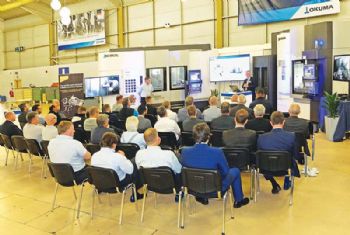
A pair of one-day seminars on gear manufacturing held at NCMT’s Coventry technical centre and showroom (27-28 June) attracted more than 70 visitors.
They were shown how it is possible to achieve world-leading accuracy when producing gears and splines on standard machine tools built by Okuma in Japan. The company’s products are sold in the UK and Ireland exclusively by NCMT Ltd, Thames Ditton (
www.ncmt.co.uk).
NCMT engineering director Adrian Maughan said: “There is an increasing interest in producing gearboxes that are more compact, lighter and more efficient.
“The flexibility, high productivity and lower investment cost offered by producing gears on five-axis machining centres or multi-tasking lathes — coupled with their high levels of accuracy and repeatability — make them ideal for this application.
“We not only showed the wide range of external and internal gear types that can be machined but also confirmed the high level of precision that can be attained by measuring them on our recently installed Leitz CMM with the latest Quindos software from Hexagon Manufacturing Intelligence.”
NCMT says the combination of hardware and software offered on standard Okuma machines places the company at the forefront of gear production on multi-tasking platforms.
Demonstrations at the seminars were performed on a Multus U3000 2SW turn-mill centre, while power skiving was shown on an MU4000V-L five-axis vertical machining centre.
Power skiving is a process for producing gears in large volumes to high accuracy using a dedicated tool for each type and size of gear, with the skiving tool sequentially roughing and finishing the component.

The 3.9-module spur gear produced during the demonstrations had a deep tooth profile that required robust machine tools to skive the finished product from a solid billet.
Using its Leitz CMM, NCMT showed that a Class 6 spur gear could be produced by power skiving on the Multus machine. The company said that accurate synchronisation between rotation of the tool and the workpiece is essential
to achieve this level of accuracy.
Another process demonstrated was Invo-Milling, a flexible machining technique that can produce different gears using the same standard milling tool. Meanwhile, helical and spur gears ranging from Module 2 to 12 can be produced with just two tools; other tools are available to cover the Module range from 0.5 to 100.
Ideal process
NCMT says this milling process is ideal for prototyping and small- to medium-batch production, as well as for producing larger Modules, pinions and complex gears such as herring bone-types with a gap between adjacent rows of teeth (also known as double helical gears, they are designed to ‘neutralise’ axial loads).
Neither is there any limitation to the root form; and the use of standard tools means it is possible to cut lead times by not having to wait for special tools to be made. Other gear-production techniques and their relative benefits were covered during the presentations; these included hobbing using a carbide-insert cutter, shaping
and spiral bevel milling.
The dimensional accuracy achieved on Okuma milling and turning machines, along with the ability for machined gear tooth flanks to appear as though they have been ground, requires comprehensive management of thermal growth.
Okuma says effective control lies in the design and construction of its machines for predictable movement, which ensures that deformation occurs in a linear and predictable manner.
Okuma calls its compensation system the Thermo-Friendly Concept (TFC), which combines the attributes of the machine construction, open-architecture OSP control and elements — such as covers and peripheral equipment — that have been designed to eliminate hot spots and help equalise the effects of variations in ambient temperature.
TFC uses two ‘thermo-active stabiliser systems’ to monitor growth — one controlling the spindle while the other controls the structure. These help to maintain the accuracy of the entire machine tool, even in environments where
temperature variations up to 8°C occur.
Other Okuma ‘intelligent technology offerings’ include: advanced automatic collision avoidance; Machining Navi, which assists operators by recommending optimal cutting conditions and parameters to suppress chatter; and Okuma’s five-axis automatic tuning system, which accurately fine-tunes the geometry of the machine, including the straightness of the axes.
Okuma manufactures practically every part of its machines, including the spindle, drives, rotary encoders, AbsoScale linear scales (these guarantee 0.05µm feedback) and the company’s proprietary OSP control.